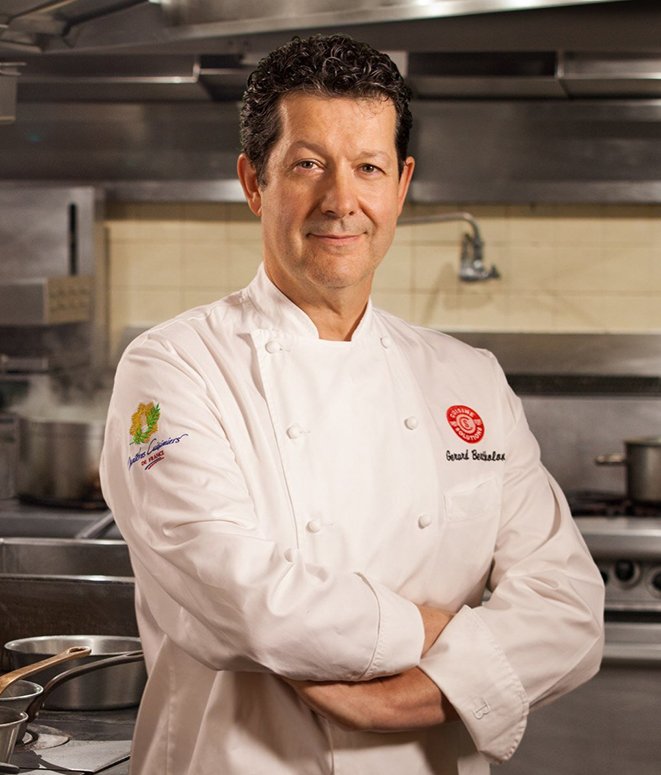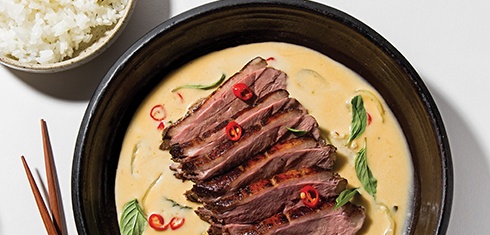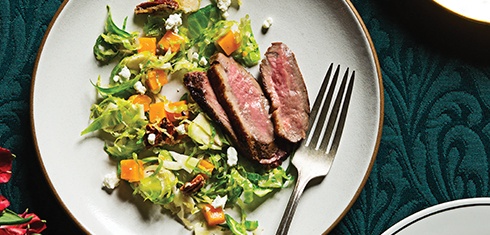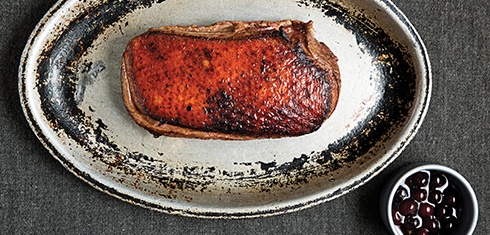
“This was one of my favorites also. A beautiful, classic, competition-style presentation.”
—Chef Gerard Bertholon, Chief Strategy Officer, Cuisine Solutions
Ingredients
Chicken Mousse:
1 Jidori chicken breast, ground
1 tsp salt
1/2 tsp white pepper
1/4 tsp garlic, granulated
1/4 tsp onion, granulated
1/4 tsp celery seeds
1 C cold heavy cream
Duck:
1 Liberty duck breast, skin removed and reserved
2 garlic cloves
2 thyme sprigs
Salt and fresh ground black pepper
Morel Duxelles:
1 duck skin (reserved)
5 oz Morel mushrooms, washed and dried
Salt and fresh ground black pepper
1 tsp butter
1 tsp minced shallot
1 tsp minced garlic
2 oz toasted panko breadcrumbs
1/2 whipped egg
1/2 tsp chopped thyme
1/2 tsp chopped parsley
Port Wine Gel:
1 qt port wine
1 pt plum wine
1 pt red wine
1 tsp salt
1 tsp sugar
2 g kappa carrageenan
4 g locust bean gum
Overview
Equipment
- Sous vide circulator
- Container for water bath
- Sous vide pouches
- Vacuum sealer
- Food processor
- Immersion blender
- Fine mesh sieve
- Combi oven
- Plastic film
- Perforated pan
- Blast freezer
Timing
Prepping time: 10 minutes / Cooking time: 50 minutes / Sous vide cooking time: 30 minutes
Servings
4-6
Directions
For the Chicken Mousse:
- In the bowl of a chilled food processor, add ground chicken and dry ingredients.
- Process for 30 seconds.
- Slowly stream heavy cream though the opening on the lid while processing to emulsify. Pause a few times during the process, and with a spatula scrape the side of the bowl to ensure it is homogeneous.
- Reserve in the refrigerator.
For the Duck:
- Season duck breast with salt and black pepper to taste. Place it inside a sous vide pouch with thyme sprigs and smashed garlic.
- Vacuum seal and reserve in the refrigerator.
For the Morel Duxelles:
- Place a sauté pan over medium heat and add duck skin. Cook undisturbed until the skin is crispy and fat has melted; about 4 minutes. Remove the skin, chop roughly, and reserve.
- Increase sauté pan heat to medium-high, add the morel mushrooms. Season with salt and pepper to taste. Add butter, shallots, and garlic. Sauté until mushrooms release liquid and then evaporate until almost dry.
- Transfer contents to the bowl of a food processor; add remaining ingredients including the chopped skin, and process until uniform. The breadcrumbs will help soak excess fat and moisture; the egg will help bind the duxelles.
- Reserve warm.
For the Port Wine Gel:
- Combine wines, salt, and sugar in a saucepan. Bring to a simmer and reduce by half. Set aside to chill.
- Transfer 500g of the reduced wine to a bowl. With an immersion blender, slowly purée in the kappa carrageenan and locust bean gum, making sure the powder doesn’t stay stuck on the blender or the sides of the container.
- Strain mixture through a fine mesh sieve into small saucepan.
- Bring mixture to a boil to activate hydrocolloids and thicken. Strain again through a fine mesh sieve into another small saucepan; cover. Reserve hot to remain fluid.
To Assemble:
NOTE: Very important to have all mise en place above ready and at the specified temperatures. Also, to go straight from start to serving without stopping to ensure a hot serving temperature. Assembly cannot be done ahead of time. Once you start, you cannot stop.
- Pre-heat sous vide water bath to 120°F (49°C) and set steam oven to high heat.
- Place sous vide duck in water bath, start timer for 20 minutes.
- After 20 minutes in the water bath, raise temperature to 130°F (54°C), start timer for 10 minutes.
- While the duck is in its last 10 minutes, line a table with enough plastic film to make three equal squares. Cut squares to separate.
- On the center of the first square, spread a thin layer of duxelles in an oval shape, or in the shape of two duck breasts side-by-side horizontally plus about an inch and a half more.
- On the second plastic film square, repeat the same process with the chicken mousse, only about 2 inches wider since the circumference will be larger.
- After a total of 30 minutes of cooking the duck, raise the temperature once more to 135°F (57°C) for 3 minutes to maintain the temperature through the wrapping process. Take out of water bath and let rest in bag for 1 minute.
- Take breast out of the vacuum pouch, pat dry, and place horizontally on the bottom half of the first square with the duxelles. Bring the top half over and fully wrap around, making sure the seams match. Pinch the ends and keep rolling the plastic wrapped duck until very tight making sure there are no air bubbles. Let rest 1 minute.
- Carefully unwrap the duck while maintaining the shape, and place on the bottom half of the chicken mousse layer as you remove the first layer of film.
- Repeat the wrapping process for the mousse again, ensuring there are no air bubbles. Roll the ends to compact the shape and tighten the mousse.
- Once more, carefully unwrap onto the third empty square and wrap tightly to create a smooth surface. Wrap tightly. This entire process should take no more than 3 minutes.
- Place duck on perforated pan and steam on high heat in a combi oven for 4 minutes.
- Take out of plastic, pat dry, and place in blast freezer for 15 seconds. This will bring down the surface temperature low enough for the gel to set but not enough to cool the inner layer of the mousse.
- After 15 seconds in the blast freezer, place on rack, and pour an even layer of gel over the duck. Let set for a few seconds, repeat twice for a total of 3 times. Now the internal temperature will bring the outside temperature back up.
- Garnish with poppy seeds, fleur de sel, and princess flowers.
- Slice into 4 or 6 pieces, serve with natural duck jus.
For a simple duck breast meal, order Cuisine Solutions’ fully cooked Char Siu Duck Breast.
Related RecipesView All Recipes
Seared Duck Breast
 Intermediate
IntermediateKaffir lime, lemongrass, green chilies: use sous vide to make your main dish sing with global flavor.
Brussels Sprouts and Duck Breast Salad
 Beginner
BeginnerHere's a winning combo: raw shaved brussels sprouts and sous vide duck breast.
Sous Vide Duck
 Beginner
BeginnerJuicy, faintly tart blueberry is a fitting counterpoint to rich, flavorful duck. Your taste buds will thank you.
Buy the Magazine
Buy NowDedicated to the Art & Science of Sous Vide
The first publication devoted to the art and science of sous vide cooking, featuring innovative recipes, visual inspiration, expert techniques for cooking sous vide at home, and exclusive interviews with world-class chefs.

 Advanced
Advanced


